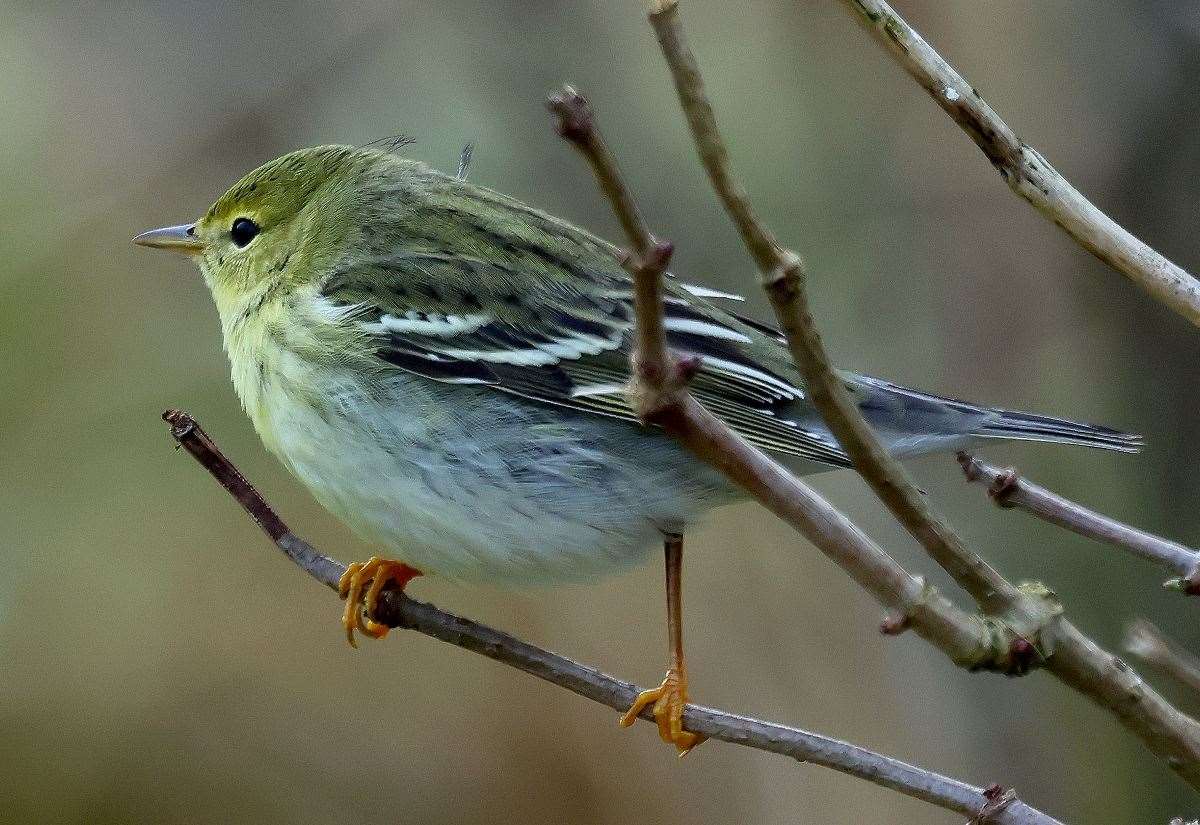Copyright shetlandtimes

The blackpoll warbler has remained in the Haroldswick area of Unst. This is only the sixth Shetland record of this rare vagrant which breeds in the coniferous forests of North America and Canada. It was probably blown off course by westerly storms when migrating over the Atlantic Ocean to winter in South America. This small warbler, weighing about 12g, makes some of the longest, non-stop trans-oceanic flights recorded for a song bird. By fitting geolocators to blackpoll warblers in Nova Scotia, researchers discovered they flew directly to Puerto Rico and Cuba before travelling on to wintering areas in Columbia and Venezuela. First winter blackpoll warblers have an olive head and upperparts, two whitish wing bars, yellowish underparts and bright yellow-orange legs and feet. When it was been feeding along the shore, the bright yellow-orange legs provided a bright contrast against the dark seaweed. In flight, the white on the outer tail feathers was clearly visible. Also from across the Atlantic, a snow goose, a local rarity, remained on Bressay this week. Snow geese have two morphs or colour phases which are genetically controlled. The white morph, the commonest form, has all-white plumage except for black wing tips. The blue morph has blue-grey plumage with a white head. Both morphs have pink legs and bills. White and blue morph snow geese interbreed, producing offspring which can be of either morph. Snow geese breed on the Arctic tundra of Greenland, North America and Siberia and winter along the Atlantic and Pacific coasts of North America. They occur in the UK as rare vagrants. However, there are also snow geese which have escaped from captivity and self-sustaining feral populations have established themselves in some areas. Geese can breed in the far north as they can withstand very cold weather. Goose down feathers provide excellent insulation. Other local rarities included short-toed lark in Unst and great white egret in Burra and Boddam Voe. The great white egret is a rare vagrant from southern Europe and is less commonly recorded in autumn. There is a small breeding population in southern England, their range expanding due to climate change. Outwith the breeding season, records of great white egrets are now more widespread. We were watching one last week in Northumberland. In winter plumage, the great white egret has a yellow bill and dark legs. Breeding adults have black bills, a greenish patch of skin below the eye and a wispy cloak of plumes on their back. The upper legs are pinkish-brown merging into black on the lower legs and feet. As bird migration begins to tail off, there were still some records of scarce migrants such as bluethroat, western subalpine warbler, barred warbler and red-breasted flycatcher. The milder weather south has delayed the onset of autumn in woodlands. However, now the trees and bushes are changing into a palette of yellow, brown and reddish colours. These changes are in response to chemical changes taking place in the leaves. Leaves contain pigments and the proportion of different pigments present in a leaf determines the colour. During spring and summer, the predominant pigment is chlorophyll. This green pigment is essential for photosynthesis and masks other pigments. As daylight, sunshine and temperatures start decrease in autumn, major changes are triggered in the leaves of deciduous trees and bushes. The tree begins to withdraw sugars from the leaves and the production of chlorophyll slows down and eventually ceases. The existing chlorophyll in the leaf is broken down and the green starts to fade. No longer masked by the presence of chlorophyll, other pigments appear. Carotenoid pigments protect the leaves from sun damage and now they start to show in vivid yellows and oranges. Before a leaf falls from a tree, a corky layer develops at the base of the stalk. This restricts any remaining sugars from being re-absorbed by the tree so they become trapped and concentrated in the dying leaves. These sugars are converted to pigments called anthocyanins which produce reds, pinks and purples in the dying leaves. Brighter reds are produced in years when the spring and summer has been warmer, sunnier and drier than average. By Joyce JM Garden Do you want to respond to this article? If so, click here to submit your thoughts and they may be published in print.



